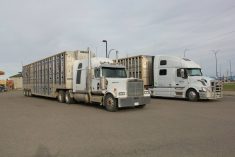CARLYLE, Sask. — Questions replaced resolutions at a recent meeting of the Saskatchewan Cattlemen’s Association’s District 1.
About 50 people attended the meeting to vote for a new director and get an update on industry issues.
They didn’t draft resolutions to send to the SCA annual general meeting in January, but they did have questions about longstanding issues.
One producer asked about the status of cattle price insurance. The Canadian Cattlemen’s Association has advocated a national program after Alberta introduced its own a couple of years ago.
Read Also

Petition launched over grazing lease controversy
Battle continues between the need for generation of tax revenue from irrigation and the preservation of native grasslands in southern Alberta rural municipality.
Outgoing chair and District 1 director Jack Hextall said there is support for the idea, but it hasn’t moved forward.
“The province hasn’t really tipped their hand on where they’re at,” he told the meeting.
Ryder Lee, CCA director of federal-provincial relations, said there has been a lot of “tire kicking” surrounding a national program.
“(Agriculture) minister (Gerry) Ritz is very strong on insurance,” he said.
Governments are also looking at how much they spend on ad hoc programming to deal with droughts and floods.
“If you had an insurance program ahead of that, maybe that would address a lot of that fallout,” Lee said.
A question that arose from this year’s excess moisture program was whether feedlots could access more than $250,000.
“The short answer is no,” Hextall replied.
The money available to intensive livestock operations to replace pens and infrastructure was capped at that amount, and he said requests to increase or remove the cap have been denied.
Under the provincial disaster assistance program, businesses with maximum gross revenues of $2 million are eligible for assistance in rural municipalities that have been designated as disaster areas.
Hextall said the SCA has asked for parity but has been refused.
“There’s a risk of quite a large feeding capacity in Saskatchewan not being there,” he said.
Producers in District 1 were among those hardest hit by a spring storm that dumped heavy snow and killed hundreds of calves.
A producer said he was grateful for the $400 per head payment available through the disaster program, but the storm could have bankrupt-e d him and the $400 should be reviewed.
Hextall agreed prices should be continually reviewed, particularly because there are still no clear triggers for AgriRecovery payments.
“They don’t need their butts kissed too damn much, ’cause it’s our money, not theirs,” said another producer.
Traceability is also an ongoing topic of concern. Hextall said the entire country has premise identification except for Saskatchewan, and there are questions about what that means for producers.
Tracking animal movement is “a long way away,” added Lee.
Meetings in all 11 SCA districts were scheduled to wrap up Oct. 31.
Results of elections in districts 1 and 3A were to be announced after the ballots were counted Nov. 1. Michael Spratt was acclaimed in District 8.















